
Book excerpt: 108 Rock Star Guitars in pictures
They’ve been beaten, banged up, sweated on, chipped, dinged and damn near destroyed; some have been left in pawnshops, one was dumped from a truck, and still another was dismissed as a throwaway piece of junk. They’ve also been admired, lusted after, and scrupulously copied by both guitar companies and budding luthiers the world over.
In photographing 108 of the more notable guitars made famous by some of the world’s most iconic axmen and women, Lisa S. Johnson realized that it wasn’t enough for her to merely take what she calls “some nice mug shots of instruments, which has been done already.” Over the course of the 17 years that it took her to compile the forthcoming book, 108 Rock Star Guitars, Johnson’s goal was “to show these guitars as true works of art, because that’s what they are, sometimes in spite of all they’ve been through.”
The lineup of guitarists whose instruments are represented in 108 Rock Star Guitars is astonishing: Beginning with her first subject, Les Paul (who write the book’s foreward before he passed in 2009), Johnson managed to photograph the guitars of Eric Clapton, Keith Richards, Jimmy Page, Lou Reed, Carlos Santana, Bruce Springsteen, Nancy Wilson, Bonnie Raitt, Rick Nielsen, Slash, Jack White, Billy Gibbons, Ace Frehley and many others.
Most of the guitarists whom Johnson contacted agreed to participate in the book project – some faster than others. However, there have been some key holdouts. “More than anyone else, I really wanted Angus Young,” she says, “but I couldn’t get my calls or e-mails returned.” Mark Knopfler, Pete Townshend, The Edge and Joan Jett have also eluded Johnson’s overtures. “Some people or their handlers just didn’t seem to get it,” she says. “Still, I managed to work with most of the people I wanted.”
Johnson says that she has already photographed 25 additional guitars for an eventual second edition. “Hopefully, the next one won’t take 17 years to put together,” she says with a laugh.
108 Rock Star Guitars will be published on October 8th by Glitterati Incorporated. The 396-page hardcover book (SRP: $108) is available for pre-order now at 108RockStarGuitars.com. You can also order the book at Amazon.
In addition, Glitterati will issue a deluxe, limited edition of 540 signed and numbered copies, packaged in a die-cut collector’s box (SRP: $540). Those books will include a hand-woven, silk chiffon scarf in deep purple, featuring the book cover design. Both editions will include a 16-page booklet, “The Inspiration Behind 108 Rock Star Guitars,” with additional behind-the-scenes photos and stories as well as a guitar pick printed with one of three custom holographic foil designs. A portion of the proceeds will benefit The Les Paul Foundation.
A generous selection of shots from 108 Rock Star Guitars can be viewed on the following pages, along with text from the book and Johnson's own observations to MusicRadar.
Text and images Lisa S. Johnson from the book 108 Rock Star Guitars by Lisa S. Johnson. © 2013 108 RockGuitars.com.

Jimmy Page - 1968 Gibson EDS 1275 - SG Double Neck
Perhaps no other guitar rises to the level of rock 'n' roll icon as much as Jimmy’s SG double neck. See it up close and you’ll swear it's been to hell and back, despite its frequent ascensions via the “Stairway to Heaven.” Jimmy performs the intro of that most famous of Zeppelin songs on the twelve-string, utilizing the six-string on the song’s more raucous sections and, of course, the solo.
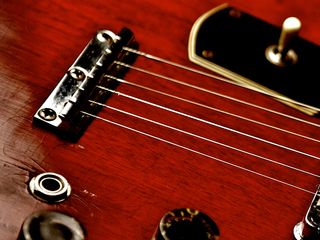
Jimmy Page - 1968 Gibson EDS 1275 - SG Double Neck
“By the time I requested Jimmy Page, we had already photographed 90 guitars or so. They said yes right away, which was the coolest thing. They asked me which guitar I wanted to shoot. I didn't know at first, so I mentioned it to Robert Knight, who is an amazing photographer, of course, and he said, ‘Well, you have to shoot the double neck. That’s the Stairway To Heaven guitar.’"

Jimmy Page - 1968 Gibson EDS 1275 - SG Double Neck
“I said to Jimmy's people, ‘whatever guitar you want to represent Stairway is fine with me.’ I wanted to leave it up to them. I was also thinking about one of his Les Pauls and the bow, because that's so 'Zeppelin.'"

Jimmy Page - 1968 Gibson EDS 1275 - SG Double Neck
“When I arrived at the shoot, somebody opened up a case and it was the double neck. Seeing it, shooting it... Wow! I’m a small person, and I felt as though the guitar was as big as me. Being so close to it was like breathing in one of the most iconic guitars ever. It’s the high priestess. Jimmy is such a cosmic being, and his guitar is an extension of that.”

Ace Frehley - Modified Gibson Les Paul - "Light Guitar"
“I didn’t actually meet Ace, but a mutual friend, Linda Rowe, who was Bob Gruen’s assistant for many years – and she passed away, sadly – knew Ace and put things together. I worked with his guitar tech and photographed three or four of his guitars."

Ace Frehley - Modified Gibson Les Paul - "Light Guitar"
“KISS was one of the first bands I ever saw live, so to be able to photograph Ace's UFO ‘light guitar’ was a real thrill. It’s a very unique guitar. It's more like a show, really.

Alex Lifeson - 1976 Gibson ES-355 - Signature Guitar
“This is my baby, the original. When I pick this guitar up and play, it feels so different. It’s got a tiny neck—that’s how they used to do them in the ’70s.” – Alex Lifeson
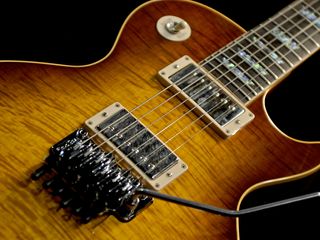
Alex Lifeson - 2007 Custom Gibson Les Paul - "Al"
From Gibson’s Custom Shop, and the foundation of what is now known as the Signature Alex Lifeson Les Paul Axcess guitar. This one features a maple sunburst finish, Floyd Rose tremolo system, and mother-of-pearl inlay. Alex had owned this guitar for only two weeks at the time of our shoot, but he liked it so much, he named it after himself.
“I worked with Alex’s guitar tech, who left me alone with the instruments for an hour backstage. He put all of the guitars on stands and just trusted me with them. It was great. The guitars were beautiful, too. You can't help but hear the music of Rush in your head as you shoot them.”

Bruce Springsteen - 1953/1954 Fender Esquire
Deemed unworthy and cast off by Fender (the dash in the serial number suggests that the guitar was a factory reject), the guitar was reinvented by master luthier/engineer Phil Petillo and sold to Springsteen for $180. Overcoming the disadvantages of its birth, the guitar performed with Springsteen through much of the ’70s and ’80s, rising to the summit of rock 'n' roll glory and becoming one of the most celebrated Esquires in history. It has appeared on a number of Springsteen album covers, including Born to Run, Bruce Springsteen & the E Street Band Live 1975 – 1985, Greatest Hits, and Wrecking Ball.

Bruce Springsteen - 1953/1954 Fender Esquire
“Bruce’s guitar was the last one I photographed for the book. By that time, I already had a massive run of guitars.
“The Esquire is so cool, and I love the fact that it was a throwaway. To think of what he's done with it... Just goes to show you, you don't always need the super-expensive guitar to make a statement."

Bruce Springsteen - 1953/1954 Fender Esquire
“There are so many stories attached to the guitar. Bruce has changed lives with it; he's made history with it. Photographing it was a very emotional experience. It's another one of those guitars that, just by looking at it, you hear the music.”

Jack White - Airline Guitar
Third Man Records had only recently established itself in Nashville when I visited in the last quarter of 2009, and its premises were quite impressive. Housed in what appears to be a former warehouse, TMR boasts a retail shop specializing in cool collectibles, record label offices complete with a kitchen, full-on photo studio and dark room, and a live venue outfitted with an analog recording console. Jack’s studio manager was my delightful host in an environment that was somehow both nostalgic and forward-thinking. I photographed the guitar Jack White made famous in The White Stripes, and which, by virtue of its red-and-white color scheme, was true to that band’s two-tone aesthetic.

Jack White - Airline Guitar
The shoot completed, I left TMR richer than when I’d arrived, and not just because of the swag I received—CDs by Dead Weather and The Raconteurs, custom red-and-white Helga camera, TMR T-shirts and stickers—but because I’d spent quality time with an instrument beloved by one of the preeminent guitarists of his generation.

Jack White - Airline Guitar
Originally manufactured by Valco, Airline guitars were sold through Montgomery Ward. Jack’s was built circa 1963/1964. He plays it with the help of a Paul Frank guitar strap.
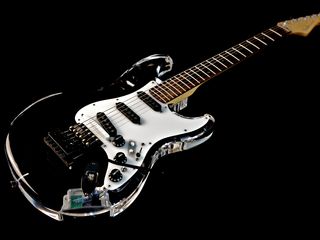
Jeff "Skunk" Baxter - 1975 Custom Roland GR 505 Synthesizer Guitar
Ask Skunk what his favorite guitar is and he will enthusiastically exclaim, “My own! A Roland synth guitar made of Plexiglas, with hand-wound Skunk-O-Sonic pickups.” It is the only such guitar in the world.
Many moons ago, exploring the world of guitar synthesizers, Skunk asked Roland to make him a six-string out of plexiglass, which he believed would minimize problems he’d been having—particularly when recording—with more resonant wood-fashioned instruments. The first such guitar was stolen out of a rental truck in 2006. Skunk asked its luthier, Makoto Sugimoto, to make him another, identical right down to The Ventures guitar pick embedded in the neck-piece (a tribute to Skunk’s favorite band). Serendipitously, considering the title of this book, the serial number on the back of the headstock contains the number 108.

Jeff "Skunk" Baxter - 1975 Custom Roland GR 505 Synthesizer Guitar
“Jeff is the nicest guy in the world. I was very pleased that I got to photograph his guitar at my studio in Malibu. He was most accommodating about it.
“I went to Jeff’s place to get his guitar, and he met me at bottom of his driveway. I’m thinking, ‘OK, he’s Mr. CIA/Mr. Security – he doesn’t want me to go into his house.’ I thought that he had these big monitors and he was watching the world. He gave me his guitar case, which was super-heavy. I got home and weighed it, and it was 18 pounds, which is a lot."
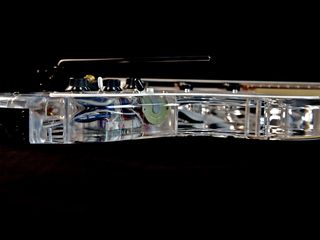
Jeff "Skunk" Baxter - 1975 Custom Roland GR 505 Synthesizer Guitar
“It’s a Roland guitar, made out of Plexiglas, so you can see the inner workings of the instrument, which is pretty cool. The other thing about it is, when you flip it around and look at the plate, embedded in it is a pick by The Ventures. Jeff has played with them. He loves The Ventures so much that he had their pic embedded in the guitar.”

Lemmy Kilmister - Rickenbacker 4004LK - "Rickenbastard"
Lemmy received the first incarnation of the Rickenbastard as a gift from bandmate Phil Campbell. It was a Rickenbacker 4001 with a Gibson Thunderbird pickup in the bridge position and a metal headstock plate that read—you guessed it—“Rickenbastard.”* Around the turn of the millennium, Rickenbacker produced a limited edition of the Lemmy Kilmister Signature 4004LK.
Sixty bastards were made in all, each sporting an elaborately hand-carved walnut top, white-checked binding, three pickups instead of the 4004’s customary two, gold hardware, and maple neck with rosewood fretboard.

Lemmy Kilmister - Rickenbacker 4004LK - "Rickenbastard"
"They brought it out to my house to be photographed, which was great because I was able to shoot it in a controlled environment. I got to spend a good deal of time with it and to examine its beauty and intricacies. And I have to tell you, you can spend hours just looking at it."

Lemmy Kilmister - Rickenbacker 4004LK - "Rickenbastard"
“It’s an incredible bass, with all of that elaborate carving in it. It’s so funny to see Lemmy, this hardcore dude, yet he has this amazing instrument with such beautiful details in it. The dichotomy is pretty interesting.”

Rick Nielsen - Fender Telecaster - "Rick of Diamonds"
“The first time I requested to shoot Rick Nielsen’s guitar, I got a one-word response: ‘No.’ That was it. Short and not sweet, but at least they responded.
“Years later, I was at Kerry Simon’s restaurant in Las Vegas – he’s the Rock ‘N’ Roll Chef – and he said, ‘You should have Rick Nielsen’s guitar in your book.’ I told him that I tried, and told me that he was having a party at the place soon, that Rick was going to be there, and I should come."

Rick Nielsen - Fender Telecaster - "Rick of Diamonds"
“I went to the party and met Rick there. While talking, I told him what happened with the one-word answer, and he was like, ‘What? Who did that? I gotta fire that guy!'"It was pretty funny.

Rick Nielsen - Fender Telecaster - "Rick of Diamonds"
“The next time there was an opportunity, I sent an e-mail, and I felt so bad – I spelled Rick’s last name wrong. It’s a hard name to spell. I screwed up like an idiot. They came back to me and said, ‘You spelled Rick’s name wrong… ‘
“Two years later, I finally got to do it. Persistence works sometimes. Rick is such a personality, and he’s got the coolest guitars.”

Robbie Robertson - 1927 Martin 000-45
This warm, inviting instrument played a feature role in the recording of Robbie’s 2011 solo album How to Become Clairvoyant, which began as a collaboration with Eric Clapton who guests on many of its tracks.

Robbie Robertson - 1961 Gibson EMS-1235 Double Neck
EMS-1235 solid bodies are rare, and hollow-bodied versions like this one rarer still. Robbie can be seen playing the eight-string mandolin neck in Martin Scorsese’s 1978 concert film The Last Waltz, which documents The Band’s final performance in 1976.
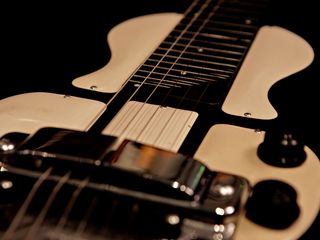
Robbie Robertson - 1930s Rickenbacker Electro Lap Steel
Robbie likes the looks of this lap steel almost as much as the noise it makes … almost. "There's a pickup on it that wastes any pickup anybody has on any instrument now,” he told Musician in 1987. “Amps start weeping at the very sound of the power this pickup puts out!"

Robbie Robertson - 1930s Rickenbacker Electro Lap Steel
“I thought that I was going to meet a guitar tech, but Robbie met me at the door to his studio. We went in and he showed me his guitars on the wall. One by one, I grabbed them and photographed them while he worked in the studio.
“Afterwards, we sat and chatted, which was great because he’s Canadian and I grew up in Canada. The Band is such an important group, one which meant a lot to me as a kid. It was a beautiful experience to sit and talk with him. He's a special man.
“His guitars are gorgeous – the 1927 Martin, the double neck, the Rickenbacker. Robbie’s double neck is the only one in the book except for Jimmy Page’s.”

Roger Waters - 1970s Fender Precision Bass-Thoroughbred
Athens, Greece. A humid 100-plus degrees in the middle of the afternoon, and fans already wait for the doors of Olympic Hall to open for the night’s concert. Roger and his band are mid-soundcheck when I arrive. Footage from “The Wall" flashes on screens above and behind the stage, in sync with each song thundered out by the musicians, Roger endearing as he issues gentle instruction to the local children’s choir that will be performing in the show.
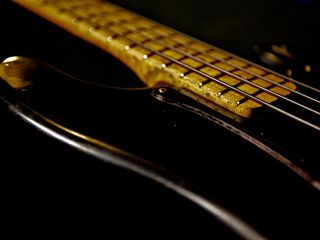
Roger Waters - 1970s Fender Precision Bass-Thoroughbred
After soundcheck I’m presented with Roger’s bass, still warm from his touch. Lacking the necessary electrical adapters for my gear, I have to take my photos with the aid of a single light bulb, while standing atop a road case beneath the stage, located exactly underneath The Wall.

Roger Waters - 1970s Fender Precision Bass-Thoroughbred
Roger first picked up this guitar during a 1979 rehearsal and almost didn’t put it down until The Wall’s first tour in 1980 was completed. He uses a black Sharpie to match the pickguard’s white edges to the bass’s all-black color scheme. Seymour Duncan pickups with extra winding provide additional punch.

Zakk Wylde - 1981 Gibson Les Paul - "The Grail"
In the days before Zakk teamed up with Ozzy, he received this guitar as a gift from his parents. Its original crème finish made it virtually indistinguishable from a Les Paul favored by Randy Rhoads (RIP); out of respect for Randy, Zakk refashioned the guitar with the bull’s eye pattern featured on movie posters for Alfred Hitchock’s “Vertigo.”

Zakk Wylde - 1981 Gibson Les Paul - "The Grail"
Although now over thirty years old, no mere statement of age does justice to this guitar’s history. While on tour a while back, a crew member left a gear trailer unlocked, and the guitar fell out mid-drive across the United States.

Zakk Wylde - 1981 Gibson Les Paul - "The Grail"
A few years later, a fan found the guitar in a pawn shop, contacted Zakk via his website, and returned it. Holy Grail anyone?

Zakk Wylde - 1989 Gibson Les Paul - "The Rebel"
Zakk takes full credit for for the scars that mar “The Rebel”—the burns document its date with a blowtorch; scratches and divots from having bottle caps pounded all over it with a hammer.

Zakk Wylde - 1989 Gibson Les Paul - "The Rebel"
The Rebel: a personification of its owner in no uncertain terms. Rumor is, this guitar is the secret weapon Zakk employs in all recording sessions. It's one cool six-string, that’s for sure.

Wayne Kramer - 2010 Signature Fender Stratocaster
“This is a fairly new guitar. It’s Wayne’s signature model that they made for him in 2010, but it’s a relic, so it’s fashioned to look like his guitar from the ‘60s. I didn’t know that when I showed up to photograph it. As I was snapping photos, I realized that it was a relic. I asked him, ‘What happened to the original guitar?’

Wayne Kramer - 2010 Signature Fender Stratocaster
“He paused, like, ‘What am I going to tell her?’ It was a strange moment or two, and then he finally said, “It went up a hole in my arm.’ His words grabbed me – I just choked.
“He told me the story about how he advertised the guitar in a paper, trying to sell it for 400 bucks. Nobody wanted to buy it; he didn’t get a single call. But he wanted a fix, so he went to a pawn shop and hocked it. God knows where that guitar is today.”
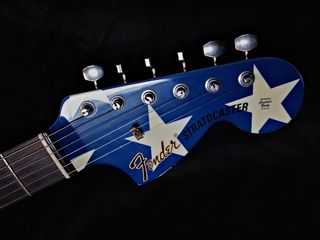
Wayne Kramer - 2010 Signature Fender Stratocaster
Wayne is an impressive man, having turned the early struggles of his life—drug addiction, the resultant stint in prison—into motivation for good works. He’s passionately committed to helping others avoid the mistakes he made, or helping others overcome the fallout from such mistakes to create better lives for themselves.
With Billy Bragg, he co-founded the United States chapter of Jail Guitar Doors, a nonprofit organization focused on the much-neglected correctional aspect of incarceration. Taking its name from The Clash’s 1978 song about Wayne’s own incarceration, Jail Guitar Doors USA provides musical equipment to prison inmates, in accord with the philosophy that education, musical and otherwise, can (re)engender an inmate’s belief in himself as a positive force and in turn allow him to successfully reintegrate into society.

Willie Nelson - 1969 Martin N-20 "Trigger"
Willie bought “Trigger” brand-new in 1969, and since then it's become one of the most famous and recognizable guitars in existence. Willie named it after Roy Rogers’ famous equine, figuring that a guitar was, to a troubadour such as himself, a kind of horse. An estimated 100 signatures adorn Trigger, including those of Leon Russell, Roger Miller, Kris Kristofferson, Gene Autry, Waylon Jennings and Johnny Cash.
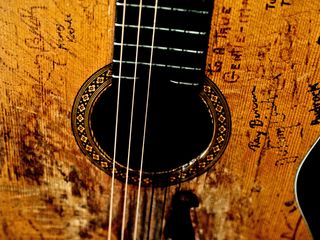
Willie Nelson - 1969 Martin N-20 "Trigger"
Countless hours of use have worn a sizeable hole through the guitar's top, but because Willie refuses to have it repaired, the two of them continue to mature together. So protective of Trigger is Willie that only extreme circumstances can induce him even to temporarily part with it. When performing, he’s known to carry the guitar on and off stage himself.
And during his well-publicised kerfuffle with the IRS, he hid it at his manager’s office to prevent it from being seized. Trigger might nearly always be in Willie’s possession, but considering its long and storied past in music, I’d say it belongs to the whole world—just like the troubadour who keeps it.

Willie Nelson - 1969 Martin N-20 "Trigger"
Celebrating his 75th birthday near the day I photographed Trigger, Willie is “still smokin’,” as his custom guitar picks advertise.

Joe is a freelance journalist who has, over the past few decades, interviewed hundreds of guitarists for Guitar World, Guitar Player, MusicRadar and Classic Rock. He is also a former editor of Guitar World, contributing writer for Guitar Aficionado and VP of A&R for Island Records. He’s an enthusiastic guitarist, but he’s nowhere near the likes of the people he interviews. Surprisingly, his skills are more suited to the drums. If you need a drummer for your Beatles tribute band, look him up.

“The electronics are just as authentic and deliver all of the sonic character of Jimmy’s legendary EDS-1275”: Gibson unveils meticulous Custom Shop VOS replica of Jimmy Page’s iconic 1969 Doubleneck

“The mahogany armrest enhances comfort and aesthetics”: Harley Benton debuts the impressive yet affordable CLO and CLG acoustics, featuring all-solid spruce and rosewood builds, Fishman electronics and an inviting armrest

“The electronics are just as authentic and deliver all of the sonic character of Jimmy’s legendary EDS-1275”: Gibson unveils meticulous Custom Shop VOS replica of Jimmy Page’s iconic 1969 Doubleneck

“The mahogany armrest enhances comfort and aesthetics”: Harley Benton debuts the impressive yet affordable CLO and CLG acoustics, featuring all-solid spruce and rosewood builds, Fishman electronics and an inviting armrest
Most Popular








